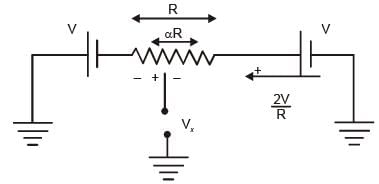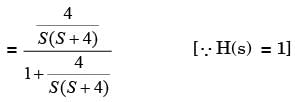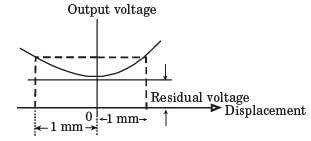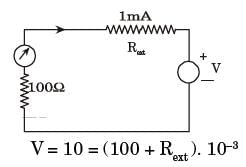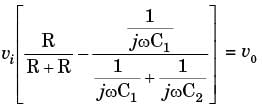Test: Sensor & Industrial Instrumentation- 1 - GATE MCQ
25 Questions MCQ Test - Test: Sensor & Industrial Instrumentation- 1
In the potentiometer circuit shown in the figure, the expression for Vx is (2015)


The given circuit represents_____. (2014)
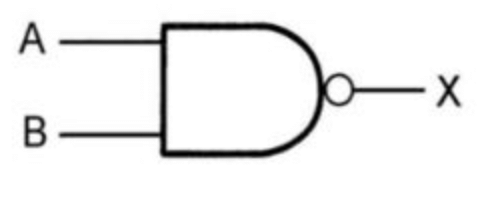

The given graph is the solution of the differential equation (2014)
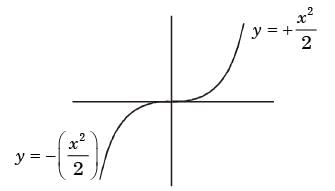

Compared to the upstream to the throat of a venturi meter, which of the following is true (2014)
The pressure at a remote point is measured by an instrumentation system comprising a transmitter [specified accuracy (SA) within ± 0.3%], a relay (SA within ± 1.1%), and a receiver element (SA with ± 0.6%). The maximum possible error of the measurement system will be (2014)
A white noise process X(t) with two-sided power spectral density 1 x 10-10 W/Hz is input to a filter whose magnitude squared response is shown below. (2014)
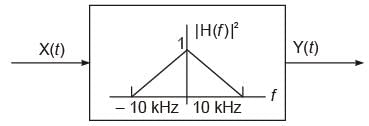
The power of the output process Y(t) is given by
If for the given system (2014)

Then the natural frequency of the system is
The characteristics of a thermometer measuring ambient temperature is  , where Ti and Tα are the indicated and ambient temperatures, respectively, both in °C, and time is in seconds. The -3 dB cut-off frequency in the frequency response of the thermometer is (2011)
, where Ti and Tα are the indicated and ambient temperatures, respectively, both in °C, and time is in seconds. The -3 dB cut-off frequency in the frequency response of the thermometer is (2011)
For a copper-constantan (Type T) thermocouple, the junction potential E (in μV) at θ°C is given by E = 38.74θ + 3.3 x 10-2θ2 + 2.07 x 10-4 θ3 - 2.2 x 10-6 θ4 + higher order terms, assuming the cold junction compensation. The sensitivity of thermocouple at 100°C is approximately (2011)
A turbine flowmeter is rotating at 72 rpm. The flux ψ linked to the nearby magnet and coil assembly is given by ψ(θ) = 3 + cos (4θ) mWb, where θ is the angular position (in radian). The amplitude and frequency of the output voltage signal, respectively, are (2011)
The seismic mass of an accelerometer oscillates sinusoidally at 100 Hz with a maximum displacement of 10 mm from its mean position. The peak acceleration of the seismic mass is (2010)
A differential pressure transmitter is used to measure the flow rate in a pipe. Due to aging, the sensitivity of the pressure transmitter is reduced by 5%. All other aspects of the flow meter remaining constant; change in the sensitivity of the flow measurement is (2010)
An LVDT is supplied with a sinusoidal voltage of amplitude 5 V and frequency 1 kHz. The output is connected to an ac voltmeter. The reading of the voltmeter is 1 V for a displacement of 1 mm from the null position. When the displacement is 1 mm in the opposite direction from the null position, the reading of the voltmeter is (2009)
A piezoelectric type pressure sensor has a sensitivity of 1 mV/kPa and a bandwidth of 300 Hz to 300 kHz. For a constant (dc) pressure of 100 kPa, the steady-state output of the sensor in millivolt is____. (2016)
A quantity x is calculated by using the formula
![]()
The measured values are p = 9, q = 6, r = 0.5
Assume that the measurement errors in p, q, and r are independent. The absolute maximum error in the measurement of each of the three quantities is ε. The absolute maximum error in the calculated value of x is
The response of a first-order measurement system to a unit step input is 1 - e-0.5t, where t is in seconds. A ramp of 0.1 units per second is given as the input to this system. The error in the measured value after transients have died down is (2009)
A galvanometer with internal resistance 100Ω and full-scale current 1 mA is used to realize a dc voltmeter with a full-scale range of 1V. The full-scale range of this voltmeter can be extended to 10V by connecting an external resistance of value (2009)
A stroboscopic system is used for measuring the speed of a rotating shaft. The shaft has one target mark on it. The maximum strobe rate at which synchronism is achieved is r1 flashes per minute. The next lower flash rate at which synchronism is achieved is r2 flashes per minute. The speed of the shaft in rpm is (2009)
The velocity of water flow (density 1000 kg/m3) in a horizontal pipe is measured using the PITOT tube shown below. The fluid in the U -tube manometer is mercury with a density of 13534 kg/m3. Assume g = 9.81 m/s2. If the height difference (h) is measured as 94.1 mm, the velocity of flow of water in m/s is___. (2016)
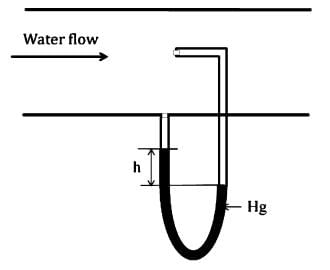
The values of the material constant p for thermistors P and Q are 4000 K and 3000 K, respectively. The resistance of each thermistor at 298 K is 2 kΩ. At 373 K, the ratio of the resistance of thermistor P to that of thermistor Q will be closest to (2009)
The speed of a gear having 60 teeth is measured using a proximity sensor. The output of the proximity sensor is fed to a counter with a gating time of 1s. The counter indicates a value of 120. The speed at which the gear is rotating is (2008)
A piezoelectric type accelerometer has a sensitivity of 100 mV/g. The transducer is subjected to a constant acceleration of 5g. The steady-state output of the transducer will be (2008)
A differential amplifier shown below has a differential mode gain of 100 and a CMRR of 40 dB. If V1 = 0.55 V and V2 = 0.45 V, output V0 is (2008)




